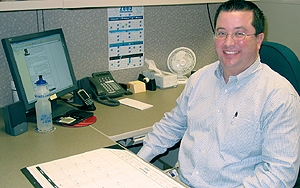
|
CONNECTIONS
|
IDAHO
ITD
HOME
IDAHO DMV
ITD NEWS
HIGHWAY
SAFETY
IDAHO STATE
POLICE
TRAVEL SERVICES
STATE OF IDAHO
NATIONAL
AASHTO
AAMVA
AAA of IDAHO
FEDERAL HIGHWAYS
FEDERAL AVIATION
IDAHO STATE POLICE
NHTSA
NTSB
TRB
U.S. DOT
Idaho
Transportation
Department
Public Affairs Office
P.O. Box 7129
Boise, ID 83707
208.334.8005
Fax: 208.334.8563
Email

Putting
information into practice
ITD's
research efforts elevated to new level
Information is the key to understanding the past and the power to influence the future. And while information is available in abundance, when access is stifled its value is diminished.
Matt Moore’s new challenge is to open the storehouse of research and make information widely available to his ITD colleagues for improving Idaho’s transportation system. Moore became the department’s first full-time research manager on Dec. 31.
 “The
key is to put research into practice,” he explains. “In
addition to providing access to research and technical information,
the real focus (of the new section) is to make it part of our everyday
practice.”
“The
key is to put research into practice,” he explains. “In
addition to providing access to research and technical information,
the real focus (of the new section) is to make it part of our everyday
practice.”
He envisions his new office becoming both a clearinghouse for research and a resource to other transportation entities. He wants to take a “proactive” approach by sharing information as it becomes available, providing a link to research headlines and abstracts, and identifying ways of incorporating it into both the decision making process and ITD services.
Gone will be the traditional way of looking at research. It will run much deeper than pavement technologies and traffic analysis. It will impact management strategies and public service, budget development, equipment acquisition, human resources and computer technologies… Research will be fundamental to everything ITD does.
“Information is another mode of transportation, and research is the engine that drives that mode.”
“It’s still about supporting what the department does, what we need to be doing,” he said. “When you step back and look at what we do, you’ll find we manage information, no matter what role we’re in, managing information, disseminating it, learning new things about it.”
Moore wasted no time immersing himself in his new role. Almost immediately after accepting the new position he participated in a Transportation Research board workshop in Washington, D.C. The TRB is part of the National Academy of Science and is the center for nearly all transportation research.
He expects to work collaboratively with a number of Idaho organizations (the Technology Transfer Center, the National Institute for Advanced Transportation Technology and the Local Highway Technical Assistance Council, among others) to identify appropriate research and introduce it to ITD. Building on existing relationships will be important, he said.
“Significant support from the (planning) division, executive management and outside partners has been very refreshing and is something we really need. This will make (research) something Idaho can be very proud of…”
Moore’s task is to elevate research to a new level of importance, affirming ITD’s leadership role in providing transportation information and working with related organizations, he explains.
His transition to research manager represents a natural migration from his duties the past seven years at ITD.
Moore has been involved in research to some extent as head of the department’s Congestion Mitigation and Air Quality program and the diligence of working with Patti Raino the past four years to identify and articulate a 30-year vision for Idaho transportation.
The visioning process opened the door to the research position, he explains
“It broadened the horizon about where we are. Once you see that broadened horizon, you learn how to share the information to benefit of participants.
“Research allows constant rethinking and re-learning;
that’s kind of fascinating and fun.”
Before coming to ITD in 1998, Moore worked for on air quality issues
for the Idaho Department of Environmental Quality (1994-1998), the Arizona
Department of Environmental Quality (1994) and for two private-sector
environmental consultants.
He earned a bachelor’s degree in resource management and public administration from Northern Arizona University (1987) and a master’s in public policy from Claremont (Calif.) Graduate University (1989).